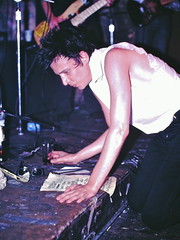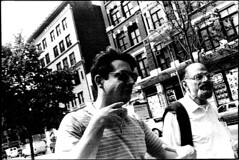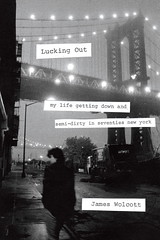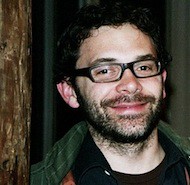Pat Ivers and Emily Armstrong continue sorting through their archives of punk-era concert footage as it’s digitized for the Downtown Collection at N.Y.U.’s Fales Library.
 Richard Hell with set list.
Richard Hell with set list.You can’t talk about punk rock without talking about Richard Hell. Television, the band he founded in 1973 with then best friend Tom Verlaine, was one of the groups – along with Blondie and the Ramones – that laid the foundation for the downtown scene at CBGBs. Sex Pistols impresario Malcolm McLaren purportedly looked at a poster of Television in 1974, pointed at Richard and said, “I want to start a band that looks like him.”
With his chopped hair and ripped-up shirt, Hell looked like nobody else. And with his kinetic, jangly stage presence and slinky bass, he sounded like nobody else. “Richard had some charisma you can’t buy in a store and apply to yourself like a cream,” recalled Television guitarist, Richard Lloyd. ”He had ‘it,’ the inimitable ‘it,’ the mysterious ‘it.’ His loopy bass lines were cartoonish in their wonderment; he was fantastic.”
Not everyone in the band agreed and Richard left to join the Heartbreakers with Johnny Thunders in 1975. But sharing stage and song time with Thunders seemed like a Television rerun for Hell: “I wanted to try something quicker, more strange than the stuff Johnny wanted,” he said. Read more…
 Rosenthal and Ginsberg.
Rosenthal and Ginsberg.Earlier this week, Allen Ginsberg’s secretary of 20 years, Bob Rosenthal, shared memories of his former employer – some of which will be included in a memoir he recently completed, “Straight Around Allen.” Speaking to The Local at Ginsberg’s former apartment on East 12th Street, where the two worked alongside each other for so long, he recalled the great poet’s daily routine, his tastes in literature and music, his mail and telephone communications, and his ways with money. Today, in our second installment, Mr. Rosenthal talks about Ginsberg’s social sphere during his two decades in the so-called poets building. Check back tomorrow for still more from this candid interview.
Allen’s East Village
People would always call Allen and say, “Allen, come to my shangri-la in Hawaii,” and here or there. He would never go. A vacation for Allen was coming back and having nothing to do in the East Village. He would often go to the poetry readings at St. Mark’s. He loved the mushroom barley soup at the Kiev. And The New York Times – he just loved it. He hung around Tompkins Square, wrote a lot of one-line poems about skinheads there. And he was a natural. I think because he always felt free here. Read more…
The Wall Street Journal sits down with longtime East Villager Richard Hell, who will introduce a screening of Robert Bresson’s “The Devil, Probably” at BAMcinématek next Thursday. The film was released in 1977, when Hell’s band the Voidoids also put out their album “Blank Generation,” and the writer-rocker sees some parallels between the two: “The complete hopelessness? The contempt for the revolutionaries and the hippies? That was exactly how I felt. ‘Please Kill Me’? That’s what that whole movie is about. Looking for some kind of compensation in obsessive sex? All my work is filled with that—hopelessness, despair and burying yourself with sex.”
 Courtesy of Doubleday
Courtesy of Doubleday Luckily for East Villagers, James Wolcott’s memoir of his days as a young culture critic in a now nearly vanished city, “Lucking Out: My Life Getting Down and Semi-Dirty in Seventies New York,” places much of its meat and potatoes (along with plenty of gravy) right here in our very own backyard. Steering a middle course between the sometimes overly concentrated, every-word-counts prose of his Vanity Fair columns, and the more loosey-goosey style he deploys in his blog at the same publication, Mr. Wolcott reconfirms his position as New York’s wittiest critic.
Despite its pleasing portability (the book, out later this month, comes in at about 270 pages), “Lucking Out” covers plenty of ground, bopping from Mr. Wolcott’s mice-ridden “man-cave” on East 12th Street, down to CBGB, and back up to the Village Voice, where he made his name. It slides west for a gawk at the gay heyday of the West Village, then uptown for some quality time among the balletomanes of Lincoln Center (with a pause for skuzzy “Taxi Driver”-era Times Square porn along the way), and includes countless screening room séances with his mentor and muse, the late New Yorker film critic, Pauline Kael, to whom large portions of the book can be seen as an extended and touching valentine. Read more…
 Courtesy of Bryan Waterman
Courtesy of Bryan WatermanWith over 80 titles now published in the acclaimed series “33 1/3” (book-length critiques of particularly esteemed pop records running the gamut from “Electric Ladyland” to “Kid A”), it has fallen to Bryan Waterman, a NYU professor, to dissect Television’s 1977 recording, “Marquee Moon.” His study, which shares a title with the album in question, weighs in at a portly 222 pages (most of the books in the series are much shorter), and will delight both Television fans and nostalgists of seventies punk-era New York. Mr. Waterman explains why the album just might be the prize catch to emerge from the glory days of CBGB.
Read more…
 jdx
jdxWould-be messages from the East Village, in 140 characters or less.
Welcome To The East Village: This is Your Demented Realtor Speaking
Here is your sofa. Studio prices are available on the
Web, or via consultation with your Personal Real Estate
Provider. Please — sit down
& be comfortable. That is garbage on the street, & you
might want to avoid that rat. Sadly, rentals are a bit high
right… Look, don’t frown,
we’ve got planeloads of Japanese heading this way very
keen to escape the recent ‘troubles,’ if you see what I
mean, you underfunded clown,
& we do need to impress upon them that this is NY, NY,
with lots of people just like them, that it’s dynamic,
diverse, & a helluva town.
(It’d be one thing if you were a minority, but you’re not
a minority, you’re not even drunk, so get off that sofa or
the cops come round)
Read more…








